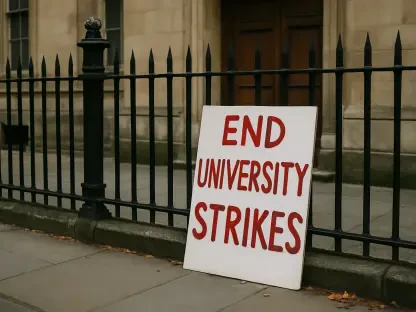Imagine a historic institution, a beacon of education for generations, teetering on the brink of collapse due to bureaucratic and financial challenges, and you have the current situation at Saint Augustine’s University. This 158-year-old historically Black college in North Carolina finds itself in a precarious position as it battles to retain its accreditation. This roundup gathers diverse perspectives from stakeholders, industry observers, and educational advocates to explore the multifaceted crisis facing the university. The purpose is to illuminate the stakes, challenges, and potential pathways forward for an institution that represents a vital piece of cultural and educational heritage.
Diverse Voices on the Accreditation Struggle
Historical Context and Current Stakes
The legacy of Saint Augustine’s University stands as a pillar of resilience within the historically Black college and university (HBCU) community. Many educational historians emphasize the profound impact of such institutions in providing access to higher education for African American students since the post-Civil War era. Today, the threat of losing accreditation from the Southern Association of Colleges and Schools Commission on Colleges (SACSCOC) looms large, with observers noting that closure could erase a critical resource for underserved communities.
A segment of academic analysts argues that accreditation is more than a bureaucratic stamp; it is the lifeline for federal funding and student enrollment. Without it, the university risks shutting down, displacing hundreds of students and staff. This perspective underscores the urgency of the current crisis, framing it as a battle not just for one school, but for the broader mission of HBCUs in addressing systemic inequities.
On the other hand, some policy experts caution against viewing accreditation as the sole measure of an institution’s worth. They suggest that while the loss would be devastating, alternative models of validation or partnerships could offer a way forward. This viewpoint, though less common, sparks debate on whether traditional accreditation processes adequately serve institutions with unique historical and financial challenges.
SACSCOC Relationship: Fairness or Overreach?
The contentious relationship between Saint Augustine’s and SACSCOC has drawn varied opinions from education watchdogs and legal analysts. Many in the academic oversight community point out that SACSCOC’s repeated actions—voting to terminate membership in 2023 and revoking accreditation again later that year over governance and funding issues—reflect a pattern of strict enforcement. They argue that such measures are necessary to maintain educational standards across the board.
Conversely, a significant number of HBCU advocates criticize SACSCOC for what they perceive as a lack of flexibility. They highlight the university’s legal claims of insufficient due process in the accreditation decisions, suggesting that the accreditor’s approach may disproportionately harm institutions already grappling with systemic financial constraints. This perspective raises questions about whether the process is equitable or if it inadvertently targets vulnerable schools.
A third angle comes from neutral observers who note the limited public response from SACSCOC itself. These commentators speculate that the accreditor’s silence may fuel perceptions of procedural opacity, leaving room for doubt about the fairness of its rulings. This ongoing tension between accountability and support remains a central point of contention in discussions surrounding the university’s fate.
Legal and Operational Responses: What Experts Say
Court Injunction: A Temporary Reprieve?
The recent federal court injunction reinstating Saint Augustine’s accreditation for the virtual fall semester starting September 2 has elicited a range of reactions. Legal scholars view this ruling as a critical lifeline, allowing the university to continue operations and serve students during a pivotal time. They commend the judiciary for stepping in where administrative processes appeared to falter, offering a chance for the institution to regroup.
However, some financial consultants warn that legal victories alone cannot solve the underlying issues. They stress that while the injunction prevents immediate closure, it does not address the operational instability or long-term funding shortages plaguing the university. This cautious outlook suggests that temporary relief must be paired with concrete reforms to ensure survival.
A smaller group of education reform advocates sees the court’s intervention as a double-edged sword. While it buys time, they argue it may delay tough but necessary decisions about the university’s structure and strategy. Their concern is that prolonged legal battles could drain resources better spent on stabilizing the institution, highlighting a need for balance between litigation and practical action.
Financial Strategies: Cuts and Fundraising in Focus
Financial experts have weighed in on the drastic measures taken by Saint Augustine’s, including a $17 million budget cut that slashed over half of its previous spending. Many applaud the aggressive cost reductions, such as reducing staff to just 40 employees, as a painful but essential step toward solvency. They argue that such moves demonstrate a commitment to fiscal responsibility, a key factor in regaining trust from accreditors and funders.
Yet, fundraising specialists point out the daunting $2 million gap that persists despite these cuts. With specific needs like $689,000 for payroll and utilities, and $650,000 for student refunds to exit the U.S. Department of Education’s Heightened Cash Monitoring 2 list, they emphasize the uphill battle ahead. Their analysis suggests that without innovative fundraising campaigns or external grants, the university’s efforts may fall short.
A contrasting opinion from community development leaders focuses on the withheld $8 million in Title IV federal aid as a systemic barrier. They argue that federal policies exacerbate the financial strain on HBCUs, calling for advocacy to reform aid distribution processes. This viewpoint shifts the conversation from internal cuts to broader policy changes needed to support struggling institutions.
Community Support: A Beacon of Hope?
The role of alumni and local supporters has garnered significant attention from social impact analysts. Many celebrate the National Alumni Association’s $100,000 contribution to the legal fight as a powerful example of grassroots resilience. They view this community backing as a cornerstone of the university’s survival strategy, proving that collective action can make a tangible difference.
Leadership consultants, however, offer a more tempered perspective on the optimism expressed by university officials. While acknowledging the symbolic importance of community rallying, they caution that multimillion-dollar shortfalls cannot be bridged by alumni donations alone. Their advice centers on leveraging this support to attract larger institutional donors or government assistance.
A unique take from cultural historians highlights the emotional and symbolic weight of community involvement. They argue that beyond financial contributions, the alumni and local backing serve as a reminder of the university’s irreplaceable role in shaping identities and histories. This intangible value, they suggest, should motivate broader efforts to save the institution, even as practical challenges persist.
Key Takeaways from the Discussion
Reflecting on the myriad perspectives, several critical insights emerged from this roundup on Saint Augustine’s University’s accreditation crisis. The legal injunction provided a vital pause, preventing immediate closure, while the deep financial deficits and systemic barriers, such as withheld federal aid, underscored the complexity of the situation. Community support stood out as a unifying force, though opinions varied on whether it could realistically address the scale of the challenges.
Looking ahead, stakeholders and observers offered actionable next steps, including the pursuit of transparent governance reforms to rebuild trust with accreditors like SACSCOC. Strategic partnerships with larger educational entities or private foundations were also suggested as a means to secure sustainable funding. Finally, advocacy for fairer accreditation and federal aid policies was seen as essential to prevent similar crises at other HBCUs, ensuring that the lessons from this struggle pave the way for systemic change.









